Munson B.R. Fundamentals of Fluid Mechanics
Подождите немного. Документ загружается.

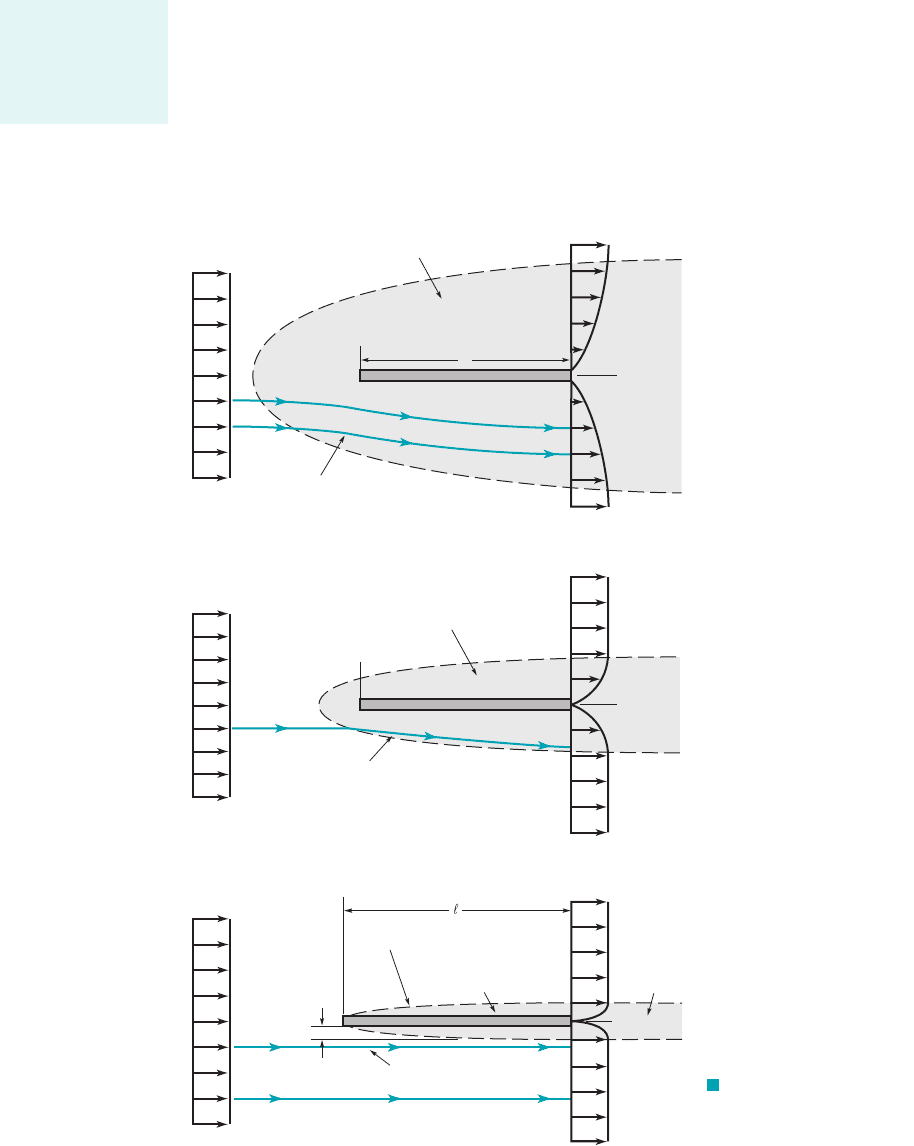
forces. The gradual settling of small particles of dirt in a lake or stream is governed by low Reynolds
number flow principles because of the small diameter of the particles and their small settling speed.
Similarly, the Reynolds number for objects moving through large viscosity oils is small because
is large. The general differences between small and large Reynolds number flow past stream-
lined and blunt objects can be illustrated by considering flows past two objects—one a flat plate
parallel to the upstream velocity and the other a circular cylinder.
Flows past three flat plates of length with and are shown in
Fig. 9.5. If the Reynolds number is small, the viscous effects are relatively strong and the plate
affects the uniform upstream flow far ahead, above, below, and behind the plate. To reach that
portion of the flow field where the velocity has been altered by less than 1% of its undisturbed
value we must travel relatively far from the plate. In low Reynolds num-
ber flows the viscous effects are felt far from the object in all directions.
As the Reynolds number is increased 1by increasing U, for example2, the region in which vis-
cous effects are important becomes smaller in all directions except downstream, as is shown in
1i.e., U ⫺ u 6 0.01 U2
10
7
Re ⫽ rU/
Ⲑ
m ⫽ 0.1, 10,/
m
9.1 General External Flow Characteristics 467
For low Reynolds
number flows,
viscous effects are
felt far from the
object.
Streamlines deflected
considerably
Re = Uᐉ/
v = 0.1
U
Viscous effects
important
u < 0.99U
y
x
U
(a)
U
u < 0.99U
y
x
Viscous effects
important
Streamlines deflected
somewhat
Re = 10
Viscosity not
important
U
Viscosity not
important
Re = 10
7
(b)
U
(c)
Viscous effects
important
Boundary layer
y
Streamlines deflection
very slight
δ
<< ᐉ
Wake
region
U
x
ᐉ
F I G U R E 9.5 Character
of the steady, viscous flow past a flat
plate parallel to the upstream velocity:
(a) low Reynolds number flow, (b) mod-
erate Reynolds number flow, (c) large
Reynolds number flow.
JWCL068_ch09_461-533.qxd 9/23/08 11:47 AM Page 467

Fig. 9.5b. One does not need to travel very far ahead, above, or below the plate to reach areas in
which the viscous effects of the plate are not felt. The streamlines are displaced from their origi-
nal uniform upstream conditions, but the displacement is not as great as for the situation
shown in Fig. 9.5a.
If the Reynolds number is large 1but not infinite2, the flow is dominated by inertial effects
and the viscous effects are negligible everywhere except in a region very close to the plate and in
the relatively thin wake region behind the plate, as shown in Fig. 9.5c. Since the fluid viscosity is
not zero it follows that the fluid must stick to the solid surface 1the no-slip boundary
condition2. There is a thin boundary layer region of thickness 1i.e., thin relative to
the length of the plate2next to the plate in which the fluid velocity changes from the upstream
value of to zero velocity on the plate. The thickness of this layer increases in the direction
of flow, starting from zero at the forward or leading edge of the plate. The flow within the bound-
ary layer may be laminar or turbulent, depending on various parameters involved.
The streamlines of the flow outside of the boundary layer are nearly parallel to the plate. As
we will see in the next section, the slight displacement of the external streamlines that are outside
of the boundary layer is due to the thickening of the boundary layer in the direction of flow. The
existence of the plate has very little effect on the streamlines outside of the boundary layer—ei-
ther ahead, above, or below the plate. On the other hand, the wake region is due entirely to the
viscous interaction between the fluid and the plate.
One of the great advancements in fluid mechanics occurred in 1904 as a result of the in-
sight of Ludwig Prandtl 11875–19532, a German physicist and aerodynamicist. He conceived of
the idea of the boundary layer—a thin region on the surface of a body in which viscous effects
are very important and outside of which the fluid behaves essentially as if it were inviscid. Clearly
the actual fluid viscosity is the same throughout; only the relative importance of the viscous ef-
fects 1due to the velocity gradients2is different within or outside of the boundary layer. As is dis-
cussed in the next section, by using such a hypothesis it is possible to simplify the analysis of
large Reynolds number flows, thereby allowing solution to external flow problems that are oth-
erwise still unsolvable.
As with the flow past the flat plate described above, the flow past a blunt object 1such as a
circular cylinder2also varies with Reynolds number. In general, the larger the Reynolds number,
the smaller the region of the flow field in which viscous effects are important. For objects that are
not sufficiently streamlined, however, an additional characteristic of the flow is observed. This is
termed flow separation and is illustrated by the figure in the margin and in Fig. 9.6.
Low Reynolds number flow past a circular cylinder is characterized by the
fact that the presence of the cylinder and the accompanying viscous effects are felt throughout a rel-
atively large portion of the flow field. As is indicated in Fig. 9.6a, for the vis-
cous effects are important several diameters in any direction from the cylinder. A somewhat surpris-
ing characteristic of this flow is that the streamlines are essentially symmetric about the center of the
cylinder—the streamline pattern is the same in front of the cylinder as it is behind the cylinder.
As the Reynolds number is increased, the region ahead of the cylinder in which viscous ef-
fects are important becomes smaller, with the viscous region extending only a short distance ahead
of the cylinder. The viscous effects are convected downstream and the flow loses its upstream to
downstream symmetry. Another characteristic of external flows becomes important—the flow sep-
arates from the body at the separation location as indicated in Fig. 9.6b. With the increase in
Reynolds number, the fluid inertia becomes more important and at some location on the body,
denoted the separation location, the fluid’s inertia is such that it cannot follow the curved path
around to the rear of the body. The result is a separation bubble behind the cylinder in which
some of the fluid is actually flowing upstream, against the direction of the upstream flow. (See
the photograph at the beginning of this chapter.)
At still larger Reynolds numbers, the area affected by the viscous forces is forced farther down-
stream until it involves only a thin boundary layer on the front portion of the cylinder and
an irregular, unsteady 1perhaps turbulent2wake region that extends far downstream of the cylinder.
The fluid in the region outside of the boundary layer and wake region flows as if it were inviscid. Of
course, the fluid viscosity is the same throughout the entire flow field. Whether viscous effects are
important or not depends on which region of the flow field we consider. The velocity gradients within
the boundary layer and wake regions are much larger than those in the remainder of the flow field.
1d D2
Re UD
n 0.1,
1Re UD
n 6 12
u U
d d1x2 /
1Re 6 2,
Re 0.1
468 Chapter 9 ■ Flow over Immersed Bodies
Thin boundary lay-
ers may develop in
large Reynolds
number flows.
V9.2 Streamlined
and blunt bodies
JWCL068_ch09_461-533.qxd 9/23/08 11:47 AM Page 468
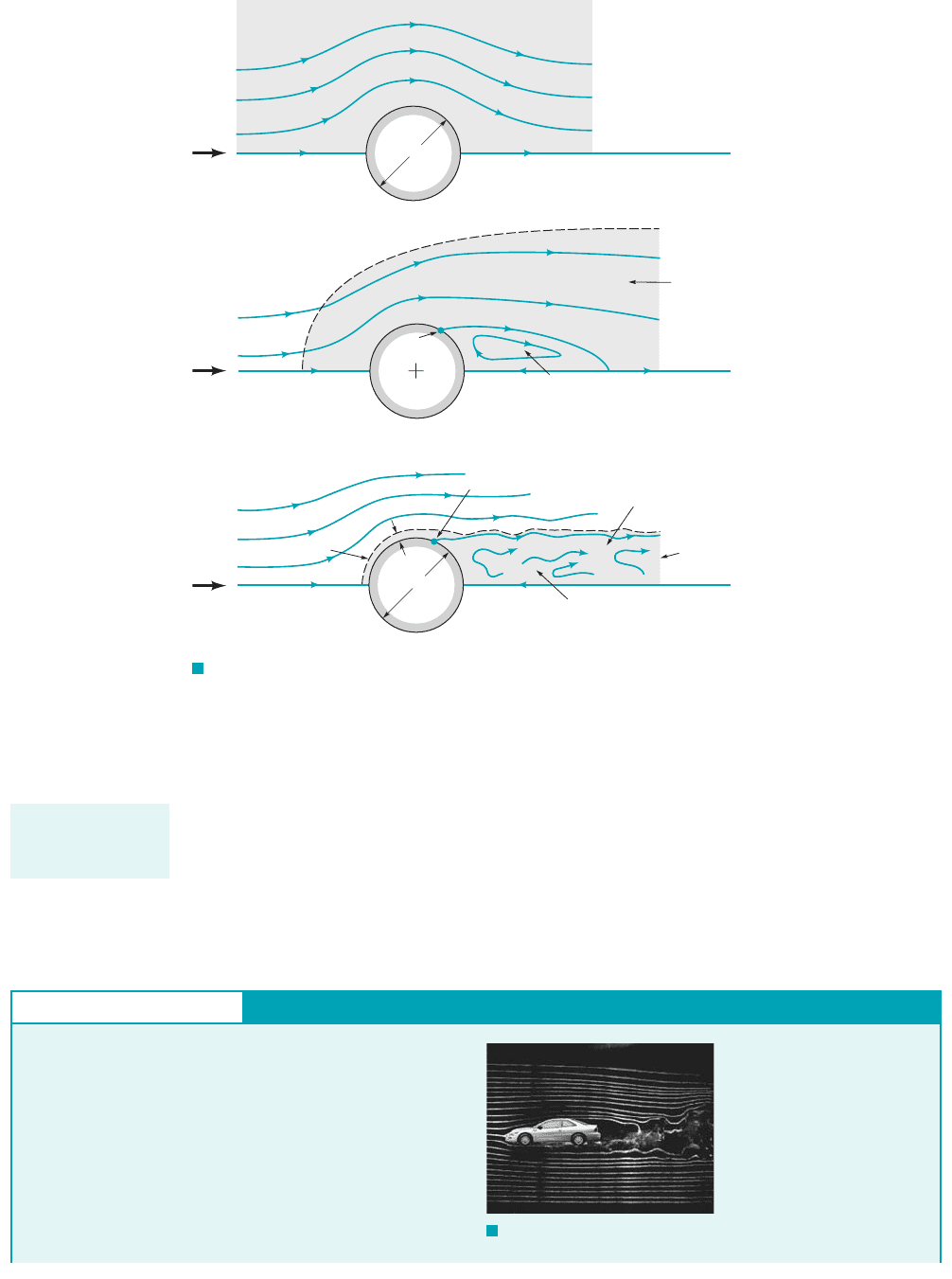
Since the shear stress 1i.e., viscous effect2is the product of the fluid viscosity and the velocity gradi-
ent, it follows that viscous effects are confined to the boundary layer and wake regions.
The characteristics described in Figs. 9.5 and 9.6 for flow past a flat plate and a circular
cylinder are typical of flows past streamlined and blunt bodies, respectively. The nature of the flow
depends strongly on the Reynolds number. (See Ref. 31 for many examples illustrating this behav-
ior.) Most familiar flows are similar to the large Reynolds number flows depicted in Figs. 9.5c and
9.6c, rather than the low Reynolds number flow situations. (See the photograph at the beginning
of Chapters 7 and 11.) In the remainder of this chapter we will investigate more thoroughly these
ideas and determine how to calculate the forces on immersed bodies.
9.1 General External Flow Characteristics 469
F I G U R E 9.6 Character of the steady, viscous flow past a circular
cylinder: (a) low Reynolds number flow, (b) moderate Reynolds number flow,
(c) large Reynolds number flow.
U
U
U
(c)
(
b)
(
a)
D
D
Boundary layer
Separated region
Viscosity not
important
Re = 10
5
δ
<< D
Boundary layer separation
Viscous effects
important
Wake
region
x
Separation bubble
Separation
location
Viscosity not
important
Re = 50
Viscous forces
important throughout
Re =
UD/v = 0.1
x
x
Viscous
effects
important
Most familiar flows
involve large
Reynolds numbers.
GIVEN It is desired to experimentally determine the various
characteristics of flow past a car as shown in Fig E9.2. The follow-
ing tests could be carried out: 1a2 flow of glycerin
past a scale model that is 34-mm tall, 100-mm long, and 40-mm
wide, 1b2 air flow past the same scale model, or
1c2 air flow past the actual car, which is 1.7-m tall, 5-m
long, and 2-m wide.
FIND Would the flow characteristics for these three situations
be similar? Explain.
U ⫽ 25 m
Ⲑ
s
U ⫽ 20 mm
Ⲑ
s
U ⫽ 20 mm
Ⲑ
s
Characteristics of Flow Past Objects
E
XAMPLE 9.2
F I G U R E E9.2
JWCL068_ch09_461-533.qxd 9/23/08 11:47 AM Page 469

470 Chapter 9 ■ Flow over Immersed Bodies
S
OLUTION
or flow past a circular cylinder, we would expect that the flow
past the actual car would behave in some way similar to the flows
shown in Figs. 9.5c or 9.6c. That is, we would expect some type
of boundary layer characteristic in which viscous effects would
be confined to relatively thin layers near the surface of the car and
the wake region behind it. Whether the car would act more like a
flat plate or a cylinder would depend on the amount of streamlin-
ing incorporated into the car’s design.
Because of the small Reynolds number involved, the flow past
the model car in glycerin would be dominated by viscous effects, in
some way reminiscent of the flows depicted in Figs. 9.5a or 9.6a.
Similarly, with the moderate Reynolds number involved for the air
flow past the model, a flow with characteristics similar to those in-
dicated in Figs. 9.5b and 9.6b would be expected. Viscous effects
would be important—not as important as with the glycerin flow, but
more important than with the full-sized car.
It would not be a wise decision to expect the flow past the full-
sized car to be similar to the flow past either of the models. The
same conclusions result regardless of whether we use or
As is indicated in Chapter 7, the flows past the model car and
the full-sized prototype will not be similar unless the Reynolds
numbers for the model and prototype are the same. It is not al-
ways an easy task to ensure this condition. One 1expensive2solu-
tion is to test full-sized prototypes in very large wind tunnels 1see
Fig. 9.12.
Re
/
.
Re
h
, Re
b
,
The characteristics of flow past an object depend on the Reynolds
number. For this instance we could pick the characteristic length
to be the height, h, width, b, or length, of the car to obtain three
possible Reynolds numbers, and
These numbers will be different because of the dif-
ferent values of h, b, and Once we arbitrarily decide on the
length we wish to use as the characteristic length, we must stick
with it for all calculations when using comparisons between
model and prototype.
With the values of kinematic viscosity for air and glycerin ob-
tained from Tables 1.8 and 1.6 as and
we obtain the following Reynolds
numbers for the flows described.
Clearly, the Reynolds numbers for the three flows are quite
different 1regardless of which characteristic length we choose2.
Based on the previous discussion concerning flow past a flat plate
n
glycerin
1.19 10
3
m
2
s,
n
air
1.46 10
5
m
2
s
/.
Re
/
U/
n.
Uh
n, Re
b
Ub
n,Re
h
/,
Reynolds (a) Model in (b) Model in (c) Car in Air
Number Glycerin Air
0.571 46.6
0.672 54.8
1.68 137.0 8.56 10
6
Re
/
3.42 10
6
Re
b
2.91 10
6
Re
h
As was discussed in the previous section, it is often possible to treat flow past an object as a com-
bination of viscous flow in the boundary layer and inviscid flow elsewhere. If the Reynolds num-
ber is large enough, viscous effects are important only in the boundary layer regions near the ob-
ject 1and in the wake region behind the object2. The boundary layer is needed to allow for the no-slip
boundary condition that requires the fluid to cling to any solid surface that it flows past. Outside of
the boundary layer the velocity gradients normal to the flow are relatively small, and the fluid acts
as if it were inviscid, even though the viscosity is not zero. A necessary condition for this structure
of the flow is that the Reynolds number be large.
9.2.1 Boundary Layer Structure and Thickness on a Flat Plate
There can be a wide variety in the size of a boundary layer and the structure of the flow within it.
Part of this variation is due to the shape of the object on which the boundary layer forms. In this
section we consider the simplest situation, one in which the boundary layer is formed on an infi-
nitely long flat plate along which flows a viscous, incompressible fluid as is shown in Fig. 9.7. If
the surface were curved 1i.e., a circular cylinder or an airfoil2, the boundary layer structure would
be more complex. Such flows are discussed in Section 9.2.6.
If the Reynolds number is sufficiently large, only the fluid in a relatively thin boundary layer
on the plate will feel the effect of the plate. That is, except in the region next to the plate the flow
velocity will be essentially the upstream velocity. For the infinitely long flat plate extend-
ing from to it is not obvious how to define the Reynolds number because there is
no characteristic length. The plate has no thickness and is not of finite length!
For a finite length plate, it is clear that the plate length, can be used as the characteristic
length. For an infinitely long plate we use x, the coordinate distance along the plate from the lead-
ing edge, as the characteristic length and define the Reynolds number as Thus, forRe
x
Ux
n.
/,
x ,x 0
V Ui
ˆ
,
9.2 Boundary Layer Characteristics
Large Reynolds
number flow fields
may be divided into
viscous and inviscid
regions.
V9.3 Laminar
boundary layer
JWCL068_ch09_461-533.qxd 9/23/08 11:47 AM Page 470
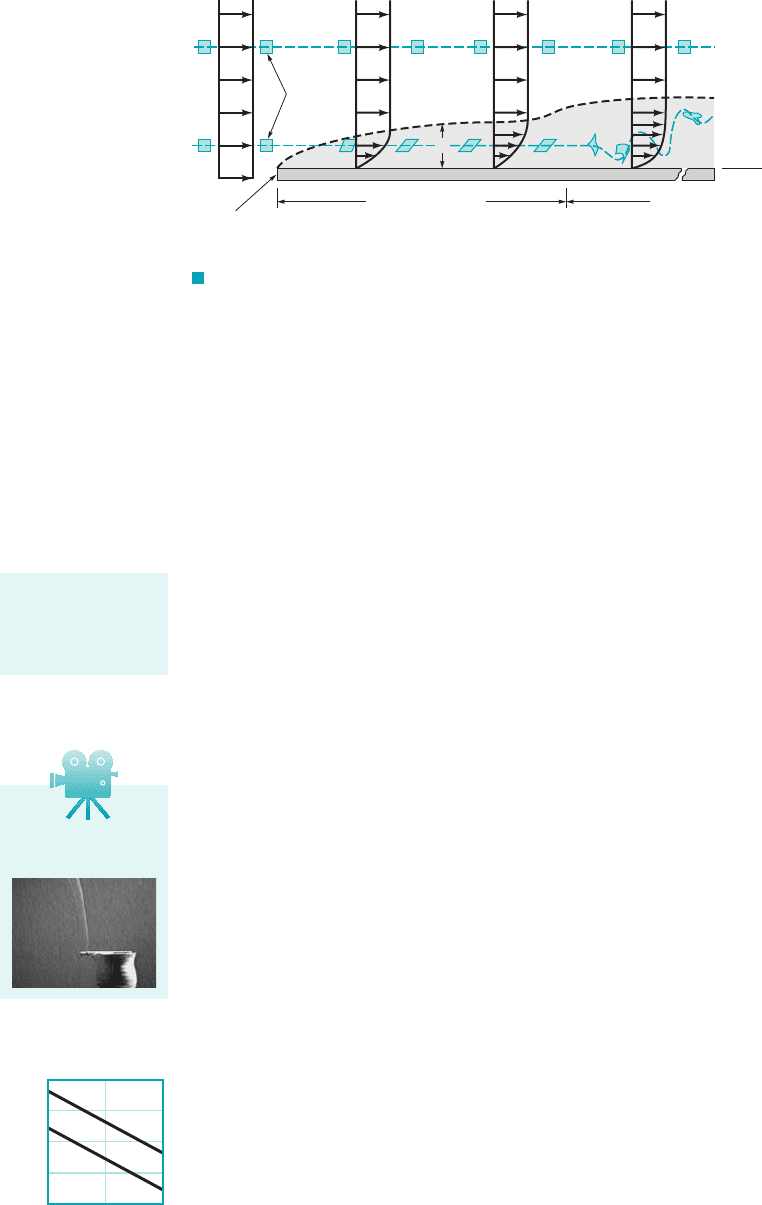
any fluid or upstream velocity the Reynolds number will be sufficiently large for boundary layer
type flow 1i.e., Fig. 9.5c2if the plate is long enough. Physically, this means that the flow situations
illustrated in Fig. 9.5 could be thought of as occurring on the same plate, but should be viewed by
looking at longer portions of the plate as we step away from the plate to see the flows in Fig. 9.5a,
9.5b, and 9.5c, respectively.
If the plate is sufficiently long, the Reynolds number is sufficiently large so that
the flow takes on its boundary layer character 1except very near the leading edge2. The details of
the flow field near the leading edge are lost to our eyes because we are standing so far from the
plate that we cannot make out these details. On this scale 1Fig. 9.5c2the plate has negligible effect
on the fluid ahead of the plate. The presence of the plate is felt only in the relatively thin bound-
ary layer and wake regions. As previously noted, Prandtl in 1904 was the first to hypothesize such
a concept. It has become one of the major turning points in fluid mechanics analysis.
A better appreciation of the structure of the boundary layer flow can be obtained by con-
sidering what happens to a fluid particle that flows into the boundary layer. As is indicated in
Fig. 9.7, a small rectangular particle retains its original shape as it flows in the uniform flow
outside of the boundary layer. Once it enters the boundary layer, the particle begins to distort
because of the velocity gradient within the boundary layer—the top of the particle has a larger
speed than its bottom. The fluid particles do not rotate as they flow along outside the boundary
layer, but they begin to rotate once they pass through the fictitious boundary layer surface and
enter the world of viscous flow. The flow is said to be irrotational outside the boundary layer
and rotational within the boundary layer. 1In terms of the kinematics of fluid particles as is dis-
cussed in Section 6.1, the flow outside the boundary layer has zero vorticity, and the flow within
the boundary layer has nonzero vorticity.2
At some distance downstream from the leading edge, the boundary layer flow becomes tur-
bulent and the fluid particles become greatly distorted because of the random, irregular nature of
the turbulence. One of the distinguishing features of turbulent flow is the occurrence of irregular
mixing of fluid particles that range in size from the smallest fluid particles up to those compara-
ble in size with the object of interest. For laminar flow, mixing occurs only on the molecular
scale. This molecular scale is orders of magnitude smaller in size than typical size scales for tur-
bulent flow mixing. The transition from a laminar boundary layer to a turbulent boundary layer
occurs at a critical value of the Reynolds number, on the order of to de-
pending on the roughness of the surface and the amount of turbulence in the upstream flow, as is
discussed in Section 9.2.4. As shown by the figure in the margin, the location along the plate
where the flow becomes turbulent, x
cr
, moves towards the leading edge as the free-stream veloc-
ity increases.
The purpose of the boundary layer is to allow the fluid to change its velocity from the upstream
value of U to zero on the surface. Thus, V 0 at y 0 and V Ui
ˆ
at the edge of the boundary layer,
with the velocity profile, u u(x, y) bridging the boundary layer thickness. This boundary layer char-
acteristic occurs in a variety of flow situations, not just on flat plates. For example, boundary lay-
ers form on the surfaces of cars, in the water running down the gutter of the street, and in the at-
mosphere as the wind blows across the surface of the earth (land or water).
3 10
6
,2 10
5
Re
xcr
,
Re U/
n
9.2 Boundary Layer Characteristics 471
F I G U R E 9.7 Distortion of a fluid particle as it flows within the
boundary layer.
δ
U UUU
Fluid
particle
Leading
edge
x = 0
Laminar boundary
layer
Turbulent boundary
layer
x
V9.4 Laminar/
turbulent transition
Fluid particles
within the boundary
layer experience
viscous effects.
x
cr
, m
100
10
1
0.1
0.01
100101
U, m/s
= 3 10
6
x
Re
cr
= 2 10
5
x
Re
cr
JWCL068_ch09_461-533.qxd 9/23/08 11:47 AM Page 471
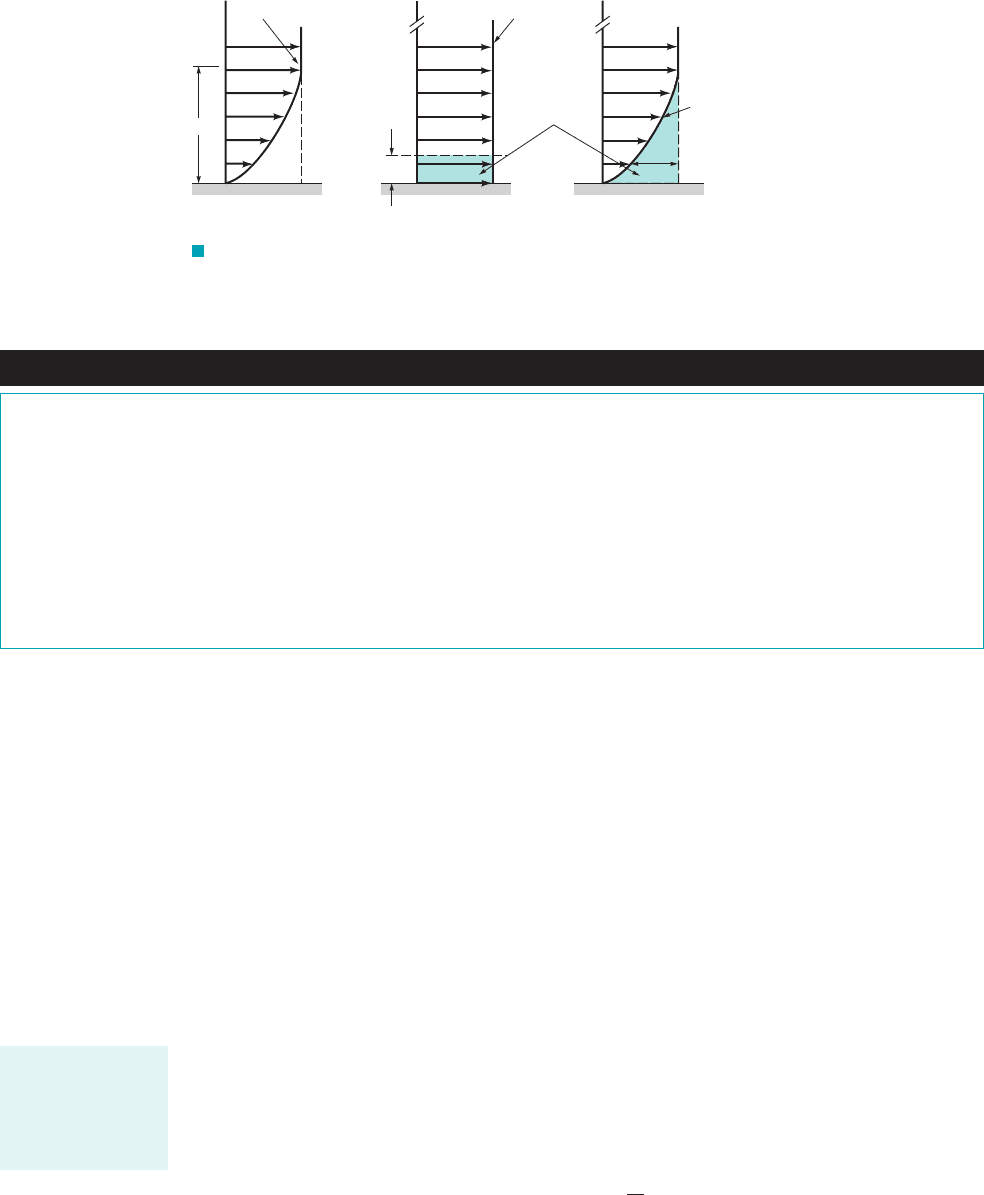
In actuality (both mathematically and physically), there is no sharp “edge” to the boundary
layer; that is, as we get farther from the plate. We define the boundary layer thickness, ␦,
as that distance from the plate at which the fluid velocity is within some arbitrary value of the
upstream velocity. Typically, as indicated in Fig. 9.8a,
where u 0.99U␦ y
u S U
472 Chapter 9 ■ Flow over Immersed Bodies
Fluids in the News
The Albatross: Nature’s Aerodynamic Solution for Long
Flights The albatross is a phenomenal seabird that soars just
above ocean waves, taking advantage of the local boundary layer
to travel incredible distances with little to no wing flapping. This
limited physical exertion results in minimal energy consumption
and, combined with aerodynamic optimization, allows the alba-
tross to easily travel 1000 km (620 miles) per day, with some
tracking data showing almost double that amount. The albatross
has high aspect ratio wings (up to 11 ft in wingspan) and a lift-
to-drag ratio (l/d) of approximately 27, both similar to high-
performance sailplanes. With this aerodynamic configuration,
the albatross then makes use of a technique called “dynamic
soaring” to take advantage of the wind profile over the ocean sur-
face. Based on the boundary layer profile, the albatross uses the
rule of dynamic soaring, which is to climb when pointed upwind
and dive when pointed downwind, thus constantly exchanging
kinetic and potential energy. Though the albatross loses energy
to drag, it can periodically regain energy due to vertical and di-
rectional motions within the boundary layer by changing local
airspeed and direction. This is not a direct line of travel, but it
does provide the most fuel-efficient method of long-distance
flight.
To remove this arbitrariness 1i.e., what is so special about 99%; why not 98%?2, the fol-
lowing definitions are introduced. Shown in Fig. 9.8b are two velocity profiles for flow past
a flat plate—one if there were no viscosity 1a uniform profile2and the other if there are vis-
cosity and zero slip at the wall 1the boundary layer profile2. Because of the velocity deficit,
within the boundary layer, the flowrate across section b–b is less than that across sec-
tion a–a. However, if we displace the plate at section a–a by an appropriate amount the
boundary layer displacement thickness, the flowrates across each section will be identical. This
is true if
where b is the plate width. Thus,
(9.3)
The displacement thickness represents the amount that the thickness of the body must be
increased so that the fictitious uniform inviscid flow has the same mass flowrate properties as
the actual viscous flow. It represents the outward displacement of the streamlines caused by the
d*
冮
0
a1
u
U
b dy
d*b U
冮
0
1U u2b dy
d*,
U u,
F I G U R E 9.8 Boundary layer thickness: (a) standard boundary
layer thickness, (b) boundary layer displacement thickness.
The boundary layer
displacement thick-
ness is defined in
terms of volumetric
flowrate.
U UU
δ
*
δ
ab
Equal
areas
ya
b
u
= 0.99 U
= 0
u = U
μ
≠ 0
u = u(y)
μ
U – u
(a)(b)
JWCL068_ch09_461-533.qxd 9/23/08 11:47 AM Page 472
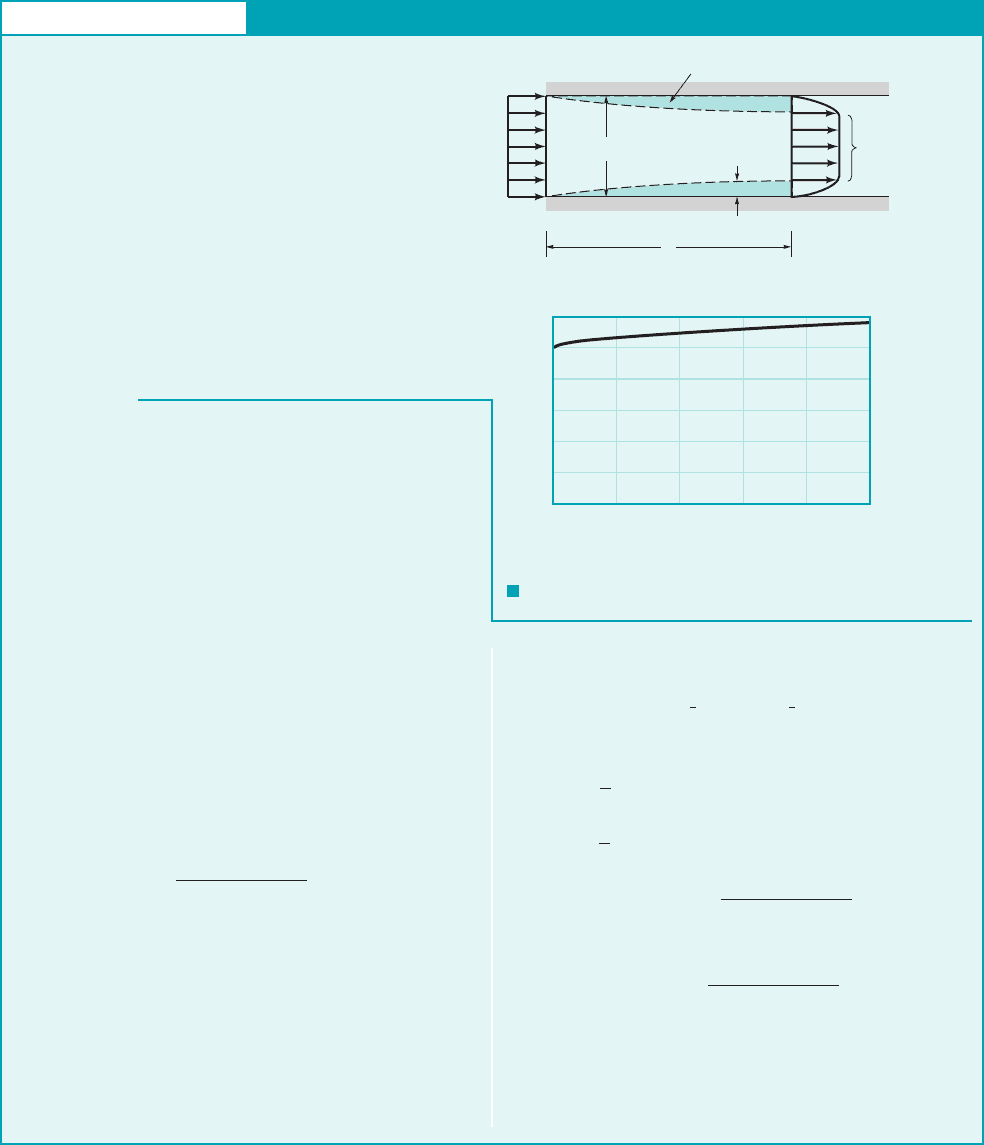
9.2 Boundary Layer Characteristics 473
GIVEN Air flowing into a 2-ft-square duct with a uniform ve-
locity of 10 ft兾s forms a boundary layer on the walls as shown in
Fig. E9.3a. The fluid within the core region 1outside the boundary
layers2flows as if it were inviscid. From advanced calculations it
is determined that for this flow the boundary layer displacement
thickness is given by
(1)
where and x are in feet.
FIND Determine the velocity of the air within the
duct but outside of the boundary layer.
U ⫽ U1x2
d*
d* ⫽ 0.00701x2
1
Ⲑ
2
S
OLUTION
F I G U R E E9.3
Boundary Layer Displacement Thickness
ever, valid for the inviscid flow outside the boundary layer.2
Thus,
Hence, with and we obtain
or
For example, at
If it were desired to maintain a constant velocity along the
centerline of this entrance region of the duct, the walls could be
displaced outward by an amount equal to the boundary layer dis-
placement thickness, d*.
x ⫽ 100 ft.p ⫽⫺0.0401 lb
Ⲑ
ft
2
p ⫽ 0.119 c1 ⫺
1
11 ⫺ 0.0070x
1
Ⲑ
2
2
4
d lb
Ⲑ
ft
2
⫻ c110 ft
Ⲑ
s2
2
⫺
10
2
11 ⫺ 0.0079x
1
Ⲑ
2
2
4
ft
2
Ⲑ
s
2
d
⫽
1
2
12.38 ⫻ 10
⫺3
slugs
Ⲑ
ft
3
2
p ⫽
1
2
r 1U
2
1
⫺ U
2
2
p
1
⫽ 0r ⫽ 2.38 ⫻ 10
⫺3
slugs
Ⲑ
ft
3
p
1
⫹
1
2
rU
2
1
⫽ p ⫹
1
2
rU
2
(1) (2)
Inviscid core
2-ft square
U(x)
x
δ
∗
Viscous effects important
U
1
=
10 ft/s
E
XAMPLE 9.3
If we assume incompressible flow 1a reasonable assumption be-
cause of the low velocities involved2, it follows that the volume
flowrate across any section of the duct is equal to that at the en-
trance 1i.e., 2. That is,
According to the definition of the displacement thickness, the
flowrate across section 122is the same as that for a uniform flow
with velocity U through a duct whose walls have been moved in-
ward by That is,
(2)
By combining Eqs. 1 and 2 we obtain
or
(Ans)
COMMENTS Note that U increases in the downstream di-
rection. For example, as shown in Fig. E9.3b, at
The viscous effects that cause the fluid to stick to the
walls of the duct reduce the effective size of the duct, thereby
1from conservation of mass principles2causing the fluid to ac-
celerate. The pressure drop necessary to do this can be obtained
by using the Bernoulli equation 1Eq. 3.72along the inviscid
streamlines from section 112to 122. 1Recall that this equation is
not valid for viscous flows within the boundary layer. It is, how-
x ⫽ 100 ft.
U ⫽ 11.6 ft
Ⲑ
s
U ⫽
10
11 ⫺ 0.0070x
1
Ⲑ
2
2
2
ft
Ⲑ
s
40 ft
3
Ⲑ
s ⫽ 4U11 ⫺ 0.0070x
1
Ⲑ
2
2
2
40 ft
3
Ⲑ
s ⫽
冮
122
u dA ⫽ U12 ft ⫺ 2d*2
2
d*.
d*,
U
1
A
1
⫽ 10 ft
Ⲑ
s 12 ft2
2
⫽ 40 ft
3
Ⲑ
s ⫽
冮
122
u dA
Q
1
⫽ Q
2
12
10
8
U, ft/s
6
4
2
0
0 20 40 60 80 100
x, ft
viscous effects on the plate. This idea allows us to simulate the presence that the boundary layer
has on the flow outside of the boundary layer by adding the displacement thickness to the ac-
tual wall and treating the flow over the thickened body as an inviscid flow. The displacement
thickness concept is illustrated in Example 9.3.
1a2
1b2
JWCL068_ch09_461-533.qxd 9/23/08 11:47 AM Page 473
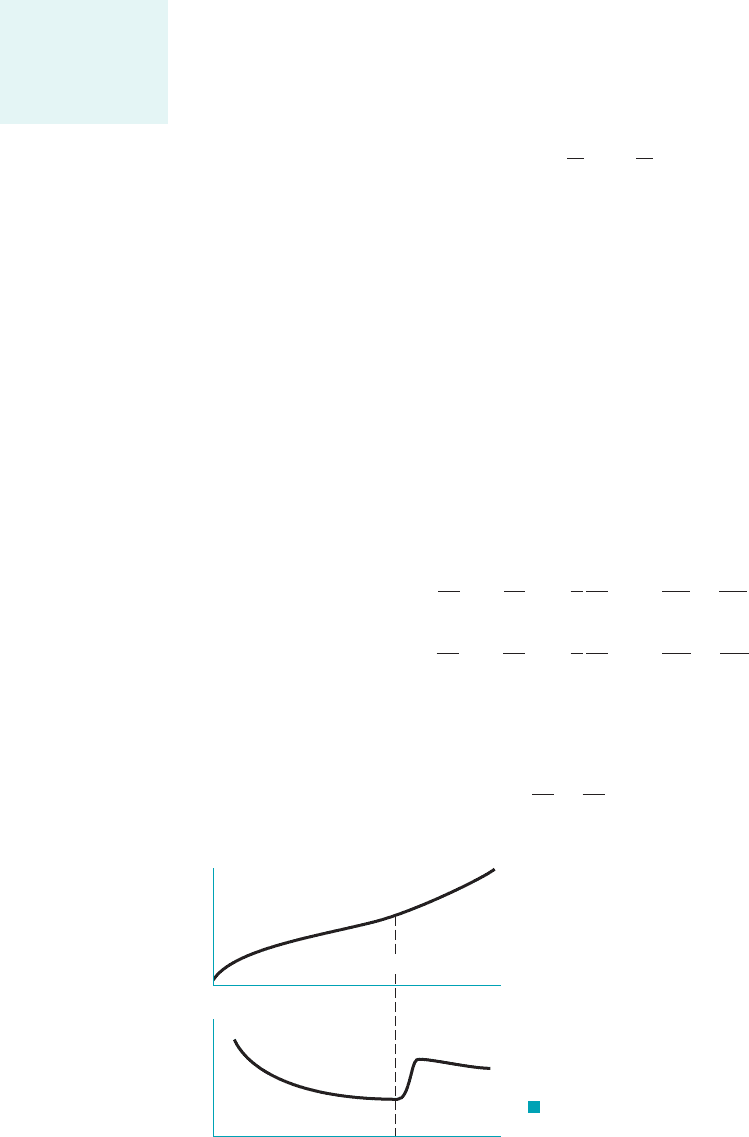
Another boundary layer thickness definition, the boundary layer momentum thickness, is
often used when determining the drag on an object. Again because of the velocity deficit,
in the boundary layer, the momentum flux across section b–b in Fig. 9.8 is less than that across
section a–a. This deficit in momentum flux for the actual boundary layer flow on a plate of width
b is given by
which by definition is the momentum flux in a layer of uniform speed U and thickness That is,
or
(9.4)
All three boundary layer thickness definitions, and are of use in boundary layer analyses.
The boundary layer concept is based on the fact that the boundary layer is thin. For the flat
plate flow this means that at any location x along the plate, Similarly, and
Again, this is true if we do not get too close to the leading edge of the plate 1i.e., not closer than
or so2.
The structure and properties of the boundary layer flow depend on whether the flow is lami-
nar or turbulent. As is illustrated in Fig. 9.9 and discussed in Sections 9.2.2 through 9.2.5, both the
boundary layer thickness and the wall shear stress are different in these two regimes.
9.2.2 Prandtl/Blasius Boundary Layer Solution
In theory, the details of viscous, incompressible flow past any object can be obtained by solving
the governing Navier–Stokes equations discussed in Section 6.8.2. For steady, two-dimensional
laminar flows with negligible gravitational effects, these equations 1Eqs. 6.127a, b, and c2reduce
to the following:
(9.5)
(9.6)
which express Newton’s second law. In addition, the conservation of mass equation, Eq. 6.31, for
incompressible flow is
(9.7)
0u
0x
0v
0y
0
u
0v
0x
v
0v
0y
1
r
0p
0y
n a
0
2
v
0x
2
0
2
v
0y
2
b
u
0u
0x
v
0u
0y
1
r
0p
0x
n a
0
2
u
0x
2
0
2
u
0y
2
b
Re
x
Ux
n 1000
™ x.d* xd x.
™,d, d*,
™
冮
0
u
U
a1
u
U
b dy
rbU
2
™ rb
冮
0
u1U u2 dy
™.
冮
ru1U u2 dA rb
冮
0
u1U u2 dy
U u,
™,
474 Chapter 9 ■ Flow over Immersed Bodies
F I G U R E 9.9 Typical characteristics of boundary
layer thickness and wall shear stress for laminar and turbulent
boundary layers.
τ
δ
w
x
x
x
Laminar Turbulent
Re
cr
The boundary layer
momentum thick-
ness is defined in
terms of momentum
flux.
JWCL068_ch09_461-533.qxd 9/23/08 11:47 AM Page 474
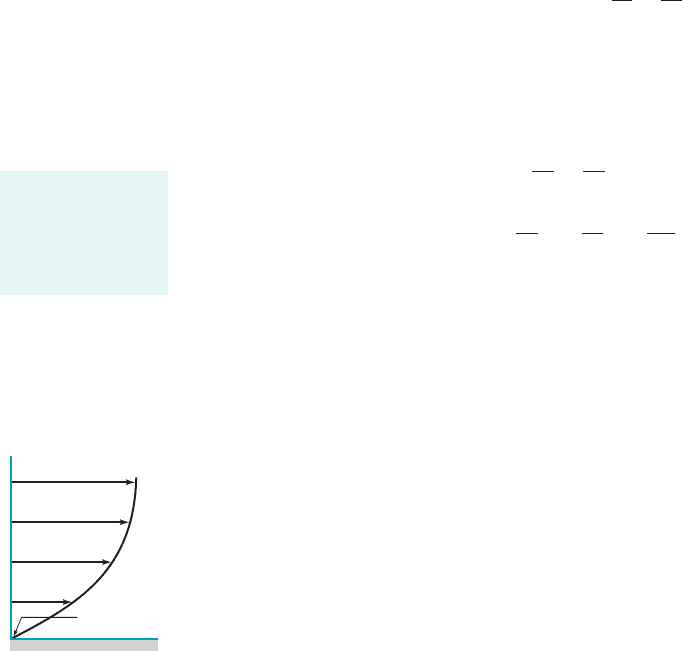
The appropriate boundary conditions are that the fluid velocity far from the body is the upstream
velocity and that the fluid sticks to the solid body surfaces. Although the mathematical problem is
well-posed, no one has obtained an analytical solution to these equations for flow past any shaped
body! Currently much work is being done to obtain numerical solutions to these governing equa-
tions for many flow geometries.
By using boundary layer concepts introduced in the previous sections, Prandtl was able to
impose certain approximations 1valid for large Reynolds number flows2, and thereby to simplify
the governing equations. In 1908, H. Blasius 11883–19702, one of Prandtl’s students, was able to
solve these simplified equations for the boundary layer flow past a flat plate parallel to the flow.
A brief outline of this technique and the results are presented below. Additional details may be
found in the literature 1Refs. 1–32.
Since the boundary layer is thin, it is expected that the component of velocity normal to the
plate is much smaller than that parallel to the plate and that the rate of change of any parameter
across the boundary layer should be much greater than that along the flow direction. That is,
Physically, the flow is primarily parallel to the plate and any fluid property is convected down-
stream much more quickly than it is diffused across the streamlines.
With these assumptions it can be shown that the governing equations 1Eqs. 9.5, 9.6, and 9.72
reduce to the following boundary layer equations:
(9.8)
(9.9)
Although both these boundary layer equations and the original Navier–Stokes equations are non-
linear partial differential equations, there are considerable differences between them. For one, the
y momentum equation has been eliminated, leaving only the original, unaltered continuity equa-
tion and a modified x momentum equation. One of the variables, the pressure, has been eliminated,
leaving only the x and y components of velocity as unknowns. For boundary layer flow over a flat
plate the pressure is constant throughout the fluid. The flow represents a balance between viscous
and inertial effects, with pressure playing no role.
As shown by the figure in the margin, the boundary conditions for the governing boundary
layer equations are that the fluid sticks to the plate
(9.10)
and that outside of the boundary layer the flow is the uniform upstream flow That is,
(9.11)
Mathematically, the upstream velocity is approached asymptotically as one moves away from the
plate. Physically, the flow velocity is within 1% of the upstream velocity at a distance of from
the plate.
In mathematical terms, the Navier–Stokes equations 1Eqs. 9.5 and 9.62and the continuity
equation 1Eq. 9.72are elliptic equations, whereas the equations for boundary layer flow 1Eqs. 9.8
and 9.92are parabolic equations. The nature of the solutions to these two sets of equations, there-
fore, is different. Physically, this fact translates to the idea that what happens downstream of a
given location in a boundary layer cannot affect what happens upstream of that point. That is,
whether the plate shown in Fig. 9.5c ends with length or is extended to length the flow within
the first segment of length will be the same. In addition, the presence of the plate has no effect
on the flow ahead of the plate. On the other hand, ellipticity allows flow information to propagate
in all directions, including upstream.
In general, the solutions of nonlinear partial differential equations 1such as the boundary layer
equations, Eqs. 9.8 and 9.92are extremely difficult to obtain. However, by applying a clever coordi-
nate transformation and change of variables, Blasius reduced the partial differential equations to an
/
2/,/
d
u S U
as
y S
u U.
u v 0
on
y 0
u
0u
0x
v
0u
0y
n
0
2
u
0y
2
0u
0x
0v
0y
0
v u
and
0
0x
0
0y
9.2 Boundary Layer Characteristics 475
The Navier–Stokes
equations can be
simplified for
boundary layer flow
analysis.
u = v = 0
u → U
y
u
JWCL068_ch09_461-533.qxd 9/23/08 11:47 AM Page 475

ordinary differential equation that he was able to solve. A brief description of this process is given be-
low. Additional details can be found in standard books dealing with boundary layer flow 1Refs. 1, 22.
It can be argued that in dimensionless form the boundary layer velocity profiles on a flat
plate should be similar regardless of the location along the plate. That is,
where is an unknown function to be determined. In addition, by applying an order of magnitude
analysis of the forces acting on fluid within the boundary layer, it can be shown that the boundary layer
thickness grows as the square root of x and inversely proportional to the square root of U. That is,
Such a conclusion results from a balance between viscous and inertial forces within the boundary
layer and from the fact that the velocity varies much more rapidly in the direction across the bound-
ary layer than along it.
Thus, we introduce the dimensionless similarity variable and the stream func-
tion where is an unknown function. Recall from Section 6.2.3 that
the velocity components for two-dimensional flow are given in terms of the stream function as
and which for this flow become
(9.12)
and
(9.13)
with the notation We substitute Eqs. 9.12 and 9.13 into the governing equations, Eqs.
9.8 and 9.9, to obtain 1after considerable manipulation2the following nonlinear, third-order ordi-
nary differential equation:
(9.14a)
As shown by the figure in the margin, the boundary conditions given in Eqs. 9.10 and 9.11 can be
written as
(9.14b)
The original partial differential equation and boundary conditions have been reduced to an ordi-
nary differential equation by use of the similarity variable The two independent variables, x and
y, were combined into the similarity variable in a fashion that reduced the partial differential equa-
tion 1and boundary conditions2to an ordinary differential equation. This type of reduction is not
generally possible. For example, this method does not work on the full Navier–Stokes equations,
although it does on the boundary layer equations 1Eqs. 9.8 and 9.92.
Although there is no known analytical solution to Eq. 9.14, it is relatively easy to integrate
this equation on a computer. The dimensionless boundary layer profile, obtained by
numerical solution of Eq. 9.14 1termed the Blasius solution2, is sketched in Fig. 9.10a and is tab-
ulated in Table 9.1. The velocity profiles at different x locations are similar in that there is only
one curve necessary to describe the velocity at any point in the boundary layer. Because the sim-
ilarity variable contains both x and y, it is seen from Fig. 9.10b that the actual velocity profiles
are a function of both x and y. The profile at location is the same as that at except that the y
coordinate is stretched by a factor of
From the solution it is found that when Thus,
(9.15) d 5
A
nx
U
h 5.0.u
U ⬇ 0.99
1x
2
x
1
2
1
2
.
x
2
x
1
h
u
U f ¿1h2,
h.
f f ¿ 0 at h 0
and
f ¿S1 as h S
2f ‡ ff – 0
1 2¿ d
dh.
v a
nU
4x
b
1
2
1h
f ¿ f 2
u Uf ¿1h2
v 0c
0x,u 0c
0y
f f1h2c 1n x U2
1
2
f 1h2,
h 1U
nx2
1
2
y
d ⬃ a
nx
U
b
1
2
g1y
d2
u
U
g a
y
d
b
476 Chapter 9 ■ Flow over Immersed Bodies
The boundary layer
equations can be
written in terms of
a similarity vari-
able.
1
1
f
f = f = 0
f → 1
η
JWCL068_ch09_461-533.qxd 9/23/08 11:47 AM Page 476
